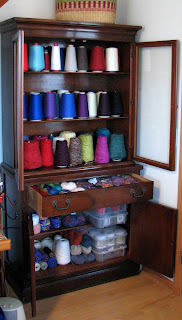Postage stamps for philatelically and technology inclined architecture lovers.
Friday, April 08, 2011
Saturday, April 02, 2011
A New Home for Yarn
First offload all of the yarn from the super cheap bookcase and put it on the treadmill
(which often does double-duty as a storage unit. More often than it's used for walking, in fact).
(which often does double-duty as a storage unit. More often than it's used for walking, in fact).
Then bring in the china cabinet from the garage where we put it after rescuing it at long last from the storage unit. Its first home that I know about was my grandmother's living room in San Antonio. (I don't really remember what she had in it specifically, but it was used in the traditional way. I do remember what was in my grandmother Nina's china cabinet, because my favorite thing to do at her house when I was a child was to take out the little china figures and animals she kept there . . . I remember some little china dogs and perhaps a shepherdess, women in kimono with fans, I think, and some others . . . and have some imaginative play time with them. I don't think I ever broke any, amazingly enough. She also kept peppermint sticks in there.)
Transfer all of the yarn to its new home!
(OK, well . . . almost all the yarn. There is still some on a couple of shelves in the laundry room.)
Rest on laurels.
Beads should be a controlled substance . . .
Really.
These are tiny 11/0 cylinder beads. (And my purely selective OCD tendencies are making an appearance, but I am telling myself I labeled the colors for the benefit of party guests.) These are Toho Treasure Beads found in my local craft store, definitely several notches above the generally available craft seed bead variety pictured below, and quite a bit spendier! Evidently it's the cylinder type beads that you need for more precise bead weaving - or is it loom beading? They have a more consistent shape and size and larger holes for multiple passes of the needle and thread. I've learned a lot about loom beading rather after the fact. The party is over, and it's a day or two later that I learn some very useful techniques for such things as warping, changing the weft threads, preferred size of needles, finishing, etc. The books I have in my stash all have a few pages about loom beading, but I learned the most from a dedicated book that I got from the library, Contemporary Loom Beading: An New Look at a Traditional Stitch. And the best site I found for online instruction of various beading techniques is at Fusion Beads.
These are tiny 11/0 cylinder beads. (And my purely selective OCD tendencies are making an appearance, but I am telling myself I labeled the colors for the benefit of party guests.) These are Toho Treasure Beads found in my local craft store, definitely several notches above the generally available craft seed bead variety pictured below, and quite a bit spendier! Evidently it's the cylinder type beads that you need for more precise bead weaving - or is it loom beading? They have a more consistent shape and size and larger holes for multiple passes of the needle and thread. I've learned a lot about loom beading rather after the fact. The party is over, and it's a day or two later that I learn some very useful techniques for such things as warping, changing the weft threads, preferred size of needles, finishing, etc. The books I have in my stash all have a few pages about loom beading, but I learned the most from a dedicated book that I got from the library, Contemporary Loom Beading: An New Look at a Traditional Stitch. And the best site I found for online instruction of various beading techniques is at Fusion Beads.
Sixteen Candles
I printed out a template graph and the guests made up their designs and got started. I helped with warping and attempted to demonstrate threading a beading needle with an assist from a needle threader, but the thread was too thick and the needles too thin and the threader too flimsy . . . eventually I broke every one of them with nary a needle threaded. The youngers had no issues with threading, though, and were able to do it without the "assist".
Subscribe to:
Comments (Atom)











